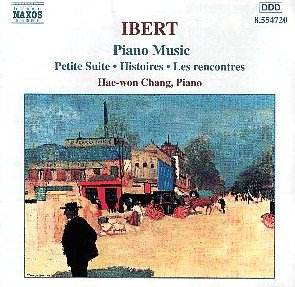Jacques IBERT (1890 - 1962)
Piano Music
Scherzetto 2'47"
Pièce romantique 5'53"
Tocatta sur le nom d'Albert Roussel 0'58"
L'espiègle au village de Lilliput 0'55"
Française: 'Guitarre 'pour le piano 2'34"
Le vent dans les ruines 2'53"
Petite Suite 16'19"
Histoires 21'43"
Les recontres 16'10"
 Hae-won Chang (piano)
Hae-won Chang (piano)
 Recorded Heidelberg, Germany.
29 / 30 Sept 1991 DDD
Recorded Heidelberg, Germany.
29 / 30 Sept 1991 DDD
Naxos 8.554720
[70'47"]
Crotchet
Amazon
UK
Amazon
USA

Jacques Ibert is one of those musicians who has an image as a lightweight,
a less than serious composer and who has not made much of a mark on the musical
mainstream. He wrote elegantly, with style and wit but varied output - for
films, stage (including two operas), and concert platform left nothing of
any great depth. Divertissement is possibly his best known work -
that's the one with police whistles in the rumbustious Finale. Somehow or
other it always leaves me with a mental image of the composer as a typical
Frenchman with a droopy black moustache and a Gauloise hanging from the side
of the mouth.
This Naxos collection does little to change our perception of the composer's
work. All but six pieces are grouped into three main sections Petite
Suite, Histoires and Les Recontres (Encounters) and with
no less than thirty-six tracks in a 70 minute time scale clearly there is
little in the way of in depth exploration of an individual subject.
These little vignettes - all titled - some representing individuals, some
moods and emotions are a varied selection. In Petite Suite en quinze
images (Little Suite in fifteen pictures) of 1943, the range includes
an open-textured pleasant Prélude, a short (49") Bach-like
fugue representing a wine grower, a Schumannesque Romance, a wistful
L'Adieu and the tiniest (a mere 34 seconds-worth) of a Cabman's
Dance slightly reminiscent of Mock Morris . The ten pieces
in Histoires from 1922, include a braying donkey in Le petit âne
blanc, a portrayal of A giddy girl with an attractively uneven
rhythm and a clearly Spanish influenced Bajo la Mesa. The closing
section - 5 pieces under the grouping of Les recontres, petite suite en
forme d ballet were the basis for a Nijinski ballet of the 1920's and
have of Flower Girls, Creoles , Precious Girls, Shepherdesses and Chatterboxes
in its gallery of images.
The playing by the Korean Hae-won Chang is assured and nicely shaded throughout
and the recording is perfectly satisfactory.
Reviewer
Harry Downey

